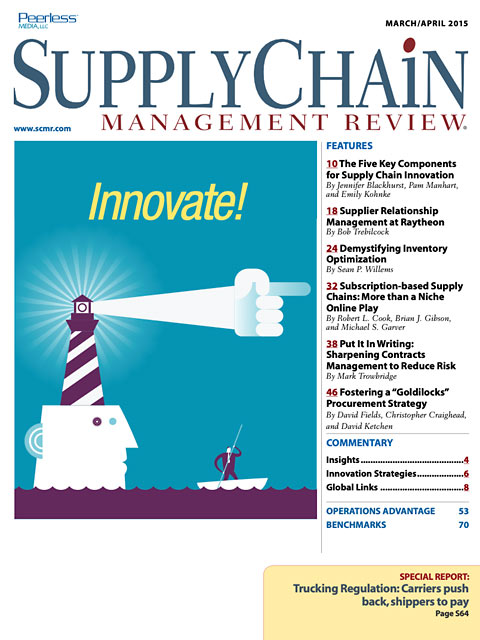Sorry, but your login has failed. Please recheck your login information and resubmit. If your subscription has expired, renew here.
March-April 2015
Anyone who’s ever bought a house knows the realtor’s motto: Location, location,location. It’s the most important factor in determining the value of a property. Based on the press releases that come across my desk these days, supply chain’s motto is: Innovate,innovate, innovate. This issue includes approaches to inventory optimization, contract management with third party logistics providers and contract manufacturers, and the Goldilocks approach to supply management—an innovative concept aimed at keeping your procurement department from running too hot or too cold. Browse this issue archive.Need Help? Contact customer service 847-559-7581 More options
While it is true that supply chains are key for sustained innovation in a company, it is also true that all innovations are not the same. A given supply chain can work perfectly for developing and launching a given innovative product, and yet—if applied like a cookie-cutter—the very same supply chain can spell disaster for a different innovative endeavor.
To illustrate this pitfall, let’s look at the fictionalized predicament of a company that we will call PixelArtist when it tried to expand into the wearable electronics market. As a first-rate innovator with a legendary supply chain, the success of PixelArtist’s expansion seemed all but guaranteed. But the company stumbled when it tried to apply an established supply chain strategy to the new venture.
Course Correction
Back in the late 1980s, when cathode ray tubes (CRT) were the dominant technology, two Caltech dropouts founded PixelArtist, Silicon Valley’s pioneer of liquid crystal displays (LCD) for computer monitors and televisions screens. After more than a decade of slow growth, the company’s market share skyrocketed at the turn of the century as old CRTs were quickly replaced by LCDs. Most of the flat screen displays sold in North America and Europe today are designed, manufactured, or built around IP from PixelArtist.
 |
This complete article is available to subscribers
only. Click on Log In Now at the top of this article for full access. Or, Start your PLUS+ subscription for instant access. |
SC
MR
Sorry, but your login has failed. Please recheck your login information and resubmit. If your subscription has expired, renew here.
March-April 2015
Anyone who’s ever bought a house knows the realtor’s motto: Location, location,location. It’s the most important factor in determining the value of a property. Based on the press releases that come across my… Browse this issue archive. Access your online digital edition. Download a PDF file of the March-April 2015 issue. |
Download Article PDF |
While it is true that supply chains are key for sustained innovation in a company, it is also true that all innovations are not the same. A given supply chain can work perfectly for developing and launching a given innovative product, and yet—if applied like a cookie-cutter—the very same supply chain can spell disaster for a different innovative endeavor.
To illustrate this pitfall, let’s look at the fictionalized predicament of a company that we will call PixelArtist when it tried to expand into the wearable electronics market. As a first-rate innovator with a legendary supply chain, the success of PixelArtist’s expansion seemed all but guaranteed. But the company stumbled when it tried to apply an established supply chain strategy to the new venture.
Course Correction
Back in the late 1980s, when cathode ray tubes (CRT) were the dominant technology, two Caltech dropouts founded PixelArtist, Silicon Valley’s pioneer of liquid crystal displays (LCD) for computer monitors and televisions screens. After more than a decade of slow growth, the company’s market share skyrocketed at the turn of the century as old CRTs were quickly replaced by LCDs. Most of the flat screen displays sold in North America and Europe today are designed, manufactured, or built around IP from PixelArtist.
 |
SUBSCRIBERS: Click here to download PDF of the full article. |
SC
MR

Latest Supply Chain News
Latest Podcast

 Explore
Explore
Topics
Latest Supply Chain News
- AdventHealth named top healthcare supply chain by Gartner
- Geopolitical readiness in supply chains: Strategic challenges for leaders
- Unlocking retention: The role employee engagement plays
- Can supply chain managers embrace an entrepreneurial mindset?
- Challenges to ESG reporting
- With capacity to spare, logistics real estate demand remains subdued
- More latest news
Latest Resources

Subscribe

Supply Chain Management Review delivers the best industry content.

Editors’ Picks





